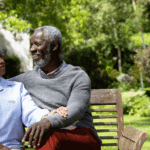Alzheimer’s doesn’t announce itself all at once. It shows up quietly at first — a repeated question, a forgotten name, a misplaced item, and gradually begins reshaping the way someone thinks, remembers, and connects. For families, these changes aren’t just medical; they’re emotional, daily, and deeply personal.
And for caregivers in Black and Brown communities, the experience can feel even heavier. Black Americans are twice as likely to develop Alzheimer’s disease as white Americans, yet they often face barriers to early diagnosis, caregiving support, and culturally competent resources.1
That’s why learning how to communicate with a loved one who has Alzheimer’s is one of the most powerful tools a caregiver can have. It creates moments of calm instead of frustration, connection instead of confusion, and dignity instead of distress.
This guide offers practical, compassionate communication strategies to support caregivers through one of the most challenging roles they may ever hold.
What Alzheimer’s Disease Really Is
Alzheimer’s disease is the most common form of dementia. It’s a condition that causes memory loss, confusion, language difficulties, and changes in behavior.2 It develops when harmful proteins build up in and around brain cells, disrupting how they communicate with each other.2
Over time, brain cells shrink and die, affecting a person’s ability to think clearly, manage daily tasks, or recognize familiar faces.2
In the early stages, someone may still hold a conversation but forget details. As the condition progresses, communication, comprehension, and recognition become increasingly difficult.2 These changes aren’t intentional, they’re neurological, and understanding this is key to responding with compassion rather than frustration.
Why Caregiver Support Is Essential
Caring for someone with Alzheimer’s is one of the most profound acts of love a person can offer, but it is also one of the most demanding. Alzheimer’s slowly shifts the roles within a family.
A daughter becomes the organizer. A spouse becomes the reminder. A sibling becomes the protector. And each shift brings its own emotional weight. Caregivers must navigate unpredictable moods, memory lapses, repeated questions, and moments of fear or disorientation that can arise without warning.
This work requires patience, flexibility, and constant emotional regulation. It means learning new skills while grieving the gradual changes in someone you love. For many caregivers, especially in Black and Brown communities, where support services are often limited and caregiving roles are culturally expected, this responsibility can lead to exhaustion, burnout, and isolation. Yet caregiving is often invisible labor, done quietly and without recognition.3
Caregiver support isn’t just helpful; it is critical. When caregivers receive education, community, respite, and emotional support, both they and their loved ones experience fewer crises, fewer communication breakdowns, and more moments of peace. Supporting the caregiver strengthens the entire caregiving relationship and ultimately improves the quality of life for everyone involved.
Why Communication Matters
Because Alzheimer’s changes how a person communicates, caregivers need practical strategies that reduce frustration, build connection, and preserve dignity. The following seven communication approaches offer guidance rooted in compassion, patience, and the everyday realities of caregiving. These strategies can help transform tense moments into calmer ones, and help caregivers feel more confident and supported as the condition progresses.
7 Communication Tips to Know About
1. Keep Your Tone Warm and Your Pace Slow
As Alzheimer’s progresses, the brain needs more time to process information.4 A warm, steady tone can help your loved one feel safe, while slower pacing gives them space to follow what you’re saying without feeling rushed or overwhelmed. Even small changes in the rhythm of your voice — pausing between thoughts, softening your volume, or lowering your speed — can dramatically change how a conversation unfolds. A gentle tone communicates respect and reassurance, even when the words themselves are simple.4
Caregiver Tip: Before speaking, take a slow breath to center yourself. Approach your loved one from the front so they can see your face, make eye contact, and start the conversation with a soft greeting (“Hi Dad, it’s me”). This sets the emotional tone long before the details of the conversation begin.
2. Use Simple, Clear Language
Alzheimer’s affects how the brain organizes and retrieves information, which can make long sentences or detailed explanations feel confusing. Clear, concise language helps create predictability and reduces frustration on both sides. Think of communication like giving directions to someone who’s unfamiliar with the route; step-by-step guidance is easier than one long explanation.4
Caregiver Tip: Break tasks or statements into one sentence at a time. If your loved one looks confused, rephrase rather than repeat louder. “Let’s get your shoes on now” is more effective than “Get ready so we can leave soon”. Keep your facial expression relaxed, nonverbal cues often speak louder than words.
3. Ask One Question at a Time
Too many choices can quickly overwhelm someone with Alzheimer’s, leading to agitation or withdrawal. Asking one question at a time allows your loved one to focus, reduces anxiety, and gives them a sense of control. Questions with yes/no answers or limited choices tend to work best.4
Caregiver Tip: If your loved one struggles to answer, gently guide without taking over. Hold up two shirts and say, “Would you like this one or this one”? If choosing still feels difficult, pick one with kindness: “Let’s wear the blue one today, it looks comfortable”. This supports independence while reducing stress.
4. Use Visual Cues and Gentle Touch
As verbal communication becomes harder, visual and sensory cues become powerful tools. Showing rather than telling — pointing toward the bathroom, demonstrating how to put on a coat, or tapping the chair you want them to sit in — can bypass confusion. Gentle touch, when welcomed, can offer grounding and reassurance.4
Caregiver Tip: Pair your visual cue with a short phrase (“This way”) and avoid sudden movements that may startle. If touch is comforting, offer your arm instead of pulling their hand, it gives support without feeling controlling. If they stiffen or look uncomfortable, switch to visual cues only.
5. Step Into Their Reality Instead of Correcting Them
Alzheimer’s can distort memory, time, and place. Insisting on accuracy often leads to fear or agitation. Stepping into their reality such as acknowledging the emotion behind their words, helps maintain connection and reduce distress.4
Caregiver Tip: If your loved one mentions needing to “pick up the kids” or asks for someone who passed away, respond to the feeling rather than the fact: “You really loved caring for them”, or “Tell me what you’re thinking about today”. Validation builds trust and keeps the interaction grounded in compassion.
6. Pay Attention to Nonverbal Signs
As language changes, behavior becomes a primary form of communication. Restlessness, pacing, irritability, withdrawal, or sudden silence can all signal unmet needs like hunger, pain, confusion, or overstimulation. Learning to read these cues helps prevent crises before they escalate.4
Caregiver Tip: When behavior shifts suddenly, mentally check for common triggers: pain, thirst, hunger, discomfort, noise, temperature, or fatigue. Keeping a small journal of patterns, what happened before the behavior, what time of day it occurred, can help you anticipate needs and create calmer routines.
7. Prioritize Your Own Care and Boundaries
Caregiving is emotionally and physically demanding, especially when done without adequate support. Many caregivers push themselves past their limits, believing they have to be strong at all times. But your well-being directly affects your loved one’s well-being. You cannot communicate clearly or compassionately when exhausted.4
Caregiver Tip: Build a “care team” rather than doing everything alone. Share responsibilities with family or close friends, or lean on community groups, church communities, or local respite services. Set boundaries around what you can manage and give yourself permission to step away when needed. Even 10 minutes of quiet can restore clarity and patience.
A Call to Action
Caring for someone with Alzheimer’s is one of the greatest acts of devotion, but it should never be a silent struggle. You deserve support, rest, and resources that honor both your role and your humanity. You are not alone and you don’t have to navigate this disease in isolation.
Download the NOWINCLUDED app to connect with caregivers who understand this journey, share tips, and offer community support rooted in culture, compassion, and shared experience.
Because caregiving may change the rhythm of your life, but you should never lose yourself in the process.
References
- NIH. (2021, December 16). Data shows racial disparities in Alzheimer’s disease diagnosis between Black and white research study participants. Retrieved from NIH: National Institute on Aging: https://www.nia.nih.gov/news/data-shows-racial-disparities-alzheimers-disease-diagnosis-between-black-and-white-research
- Alzheimer’s Association . (2025). What is Alzheimer’s Disease? Retrieved from Alzheimer’s Association: https://www.alz.org/alzheimers-dementia/what-is-alzheimers
- NIH. (2024, July 11). Alzheimer’s Caregiving: Caring for Yourself. Retrieved from NIH: National Institute on Aging: https://www.nia.nih.gov/health/alzheimers-caregiving/alzheimers-caregiving-caring-yourself
- Alzheimer’s Association. (2025). Communication and Alzheimer’s. Retrieved from Alzheimer’s Association: https://www.alz.org/help-support/caregiving/daily-care/communications








